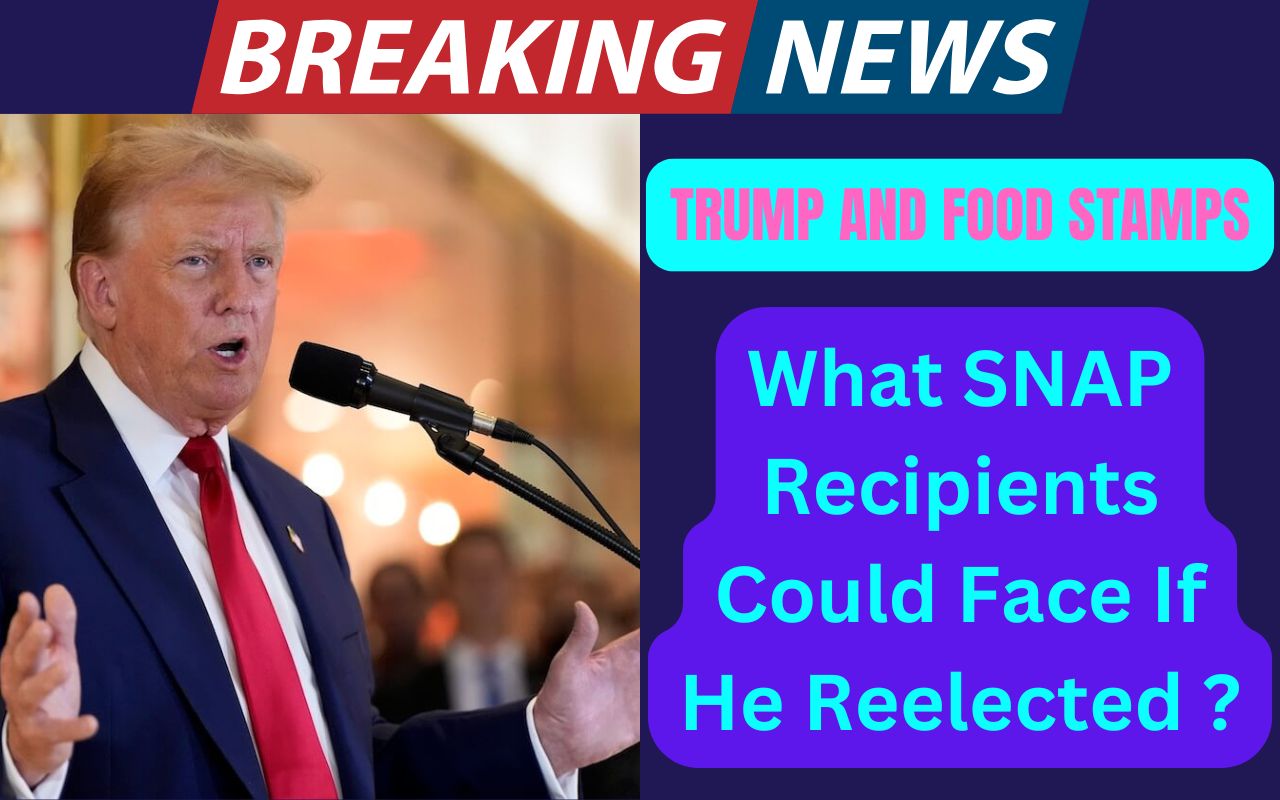Donald Trump was a president known for many changes, especially when it came to public assistance programs like SNAP. SNAP was a program that aided millions of Americans with an inexpensive means of food; therefore, it made up the most vital support system.
President Trump’s administration addressed welfare reform upon taking office. Because he was intent on encouraging employment among these recipients, such moves by President Trump sparked controversy over the potential impact on families that rely on SNAP programs.
As Trump once more runs for office, there is renewed interest in what may happen to SNAP. Here, we explore Trump’s past policies and speculate about what another term could mean for food assistance.
Donald Trump’s Food Stamps and SNAP
The welfare reform approach under Trump was very much work requirements and ways of reducing dependency on the government. His administration has proposed tighter guidelines for SNAP to lower enrollment. Some of these were work or job training hours requirements for able-bodied adults without dependents.
| Article Title | Trump and Food Stamps |
| Organization | SNAP |
| Country | USA |
| Article Type | News |
This would force people out of these assistance programs into jobs, theoretically cutting down the levels of poverty. Critics argue that it will end up hurting the most vulnerable communities.

Many of the SNAP recipients have low-wage jobs, suffer irregular hours, and are not capable of meeting set requirements. This makes it difficult to balance the goals with the realities of recipients.
Work Requirements and Their Impact
One of the significant reforms under Trump was the enforcement of work requirements for access to SNAP, where strict rules were placed on able-bodied adults that made them work or else train for a job. The effect was a reduction in reliance on government support, thereby lessening the budgetary burden of SNAP.
This overlooked the challenges in the access of others who were unable to stay employed or who failed to find training jobs. Most recipients live in rural areas with limited job opportunities, while others have other barriers, such as childcare or transportation. The broader effects of these provisions showed the difficulties of having such programs at the federal level.
What are Trump’s Plans for SNAP Eligibility Criteria?
The eligibility requirements for SNAP under Trump were to be tightened by changing the qualifications. Trump’s administration sought to limit broad-based categorical eligibility, thereby limiting the states’ authority to set their qualification criteria.
This may expand the enrollment of more students, particularly to families just slightly above the poverty line. Proponents think that it would cover more needy families when SNAP assistance is granted because of this action.
Opponents believe that this might starve some families that can barely afford to live because of their expenses. Once eligibility drops, then certain families will lose their benefits at one point in time and will be threatened with hunger, especially in the impoverished community.
Decline in the Allocation of Funds and SNAP Benefits
President Trump’s administration advised that the SNAP budget should be reduced based on the argument that the federal government should reduce welfare spending and use this money for other programs to help the economy grow, such as job training.
However, lessening of budget translates to fewer dollars for the SNAP recipients to spend on food to buy food for themselves. Thus, in this regard, opponents would say that SNAP families could not have been assured of wholesome nutrition.
The cuts also make the reduced benefits so fragile in comparison to the costs of public health and welfare since food insecurity has a lingering impact.
The Block Grant Recommendation
The Trump administration was seeking to change the SNAP funding into a state-controlled block grant. In that, the money would be provided to states discretionary according to their local needs.
The supporters of the President claimed that the block grants offer more flexibility towards increased state innovation. Critics in this line of thought argue that it would lead to inconsistent access and support because different states prioritize welfare differently.
Furthermore, the block grants might not grow as needed in economic hard times, while there will be a high demand for food assistance hence creating a shortage. How SNAP operates would change completely according to the new meaning; this would lead to questions regarding coverage and equity.
Food Box Program: An Alternative Plan?
One of the most contested initiatives under Trump was the food box proposal. It recommended replacing part of SNAP with prepackaged boxes containing preselected foods. It sought to save on the cost while ensuring the recipients receive some basic food requirements.
Critics, however, argued that this would deny people a flexible choice according to their diet and personal preference. It may reduce the effectiveness of SNAP by limiting the choices of those recipients in feeding their families.
A food box program will indeed be a radical change from what SNAP has been providing the recipients, cash aid changed into actual food.
Public Opinion and Controversy
Public opinion about Trump’s SNAP reforms was so divided that it created a lot of heat in controversy. Advocates have argued that these policies were necessary for cutting federal dependency and stimulating work. Critics say that they would hurt the poor the most, thereby plunging them deeper into poverty and food insecurity.
Advocacy groups are protesting that the reforms’ human cost would be terrible: cutting off access to food assistance would hurt the most vulnerable people. Political analysts noted that SNAP was such a high-stakes policy issue because it provided millions with a lifeline to sustain themselves.
Possible Future Changes in the Event of Re-election
If Trump returns to office, he might be able to carry out his policies in further reforming SNAP in the future. He would be able to uphold stricter eligibility and work requirements to sustain efforts to lower government spending. Trump could revisit block grants or the food box initiative as ways to cut down costs.
This would translate to higher work requirements for recipients, which might be tougher on people who are not capable of working constantly. Understanding Trump’s previous focus on policy gives insights as to what SNAP might look like under another term by concentrating much on reducing dependency.
Economic Ramifications of SNAP Reforms
The economic ramifications of reforms for SNAP by Trump involve much more than the federal budget impacts. Reductions in the level of funding for SNAP impact the local economy where more and more benefits end up making sales in the food stores.
Sales for any retailer, including in some of the low-income community outlets, would come in low as the funds of SNAP dwindle. Reduced food assistance will affect public health, leading to increased healthcare costs related to malnutrition.
Therefore, SNAP adjustments have direct and indirect implications on the economy, hence making the role of social aid programs in economic stability quite complex.
Role of SNAP in an Economic Recession
SNAP is very important to families, especially when there is an economic downfall, and it acts as an economic stabilizer at times of unemployment. When the flexibility of SNAP helped the nation during Trump’s first term. Especially with crises such as the COVID-19 pandemic, the country really needed that kind of flexibility during its time of economic downfall.
As millions of jobs disappeared overnight, SNAP supported families experiencing sudden food insecurity. If Trump comes back to office, SNAP flexibility during economic downfall would be debated, and its maintenance or increase could be an issue.
Cutting SNAP funding in times of economic adversity can erode the momentum for recovery and push more individuals into poverty. The influence of SNAP through past shocks provides a valuable perspective on its role as a responsive social safety net.
Conclusion: Equilibrium of the Pros and Cons
The potential consequences of the Trump SNAP reforms suggest an inherent conflict in the reduction of federal dependence and food security. Proponents believe strict policies promote self-reliance, which would drive an economic boost from job stimulation. Opponents argue this move would deprive poor and poorer families of basic safety nets.
| Homepage | uhmychart.org |
Hence, a SNAP policy by Trump would suggest welfare reform focusing on spending fewer federal dollars. More important is the impact of these changes on recipients, public health, and the economy in the locality. Balanced against the economic goals are social responsibility objectives, making this the heart of the debate concerning SNAP‘s future.
PV Martinez holds an MBA in Finance from the University of Michigan. When not analyzing numbers, PV enjoys playing football and spending time singing his favorite tunes.





